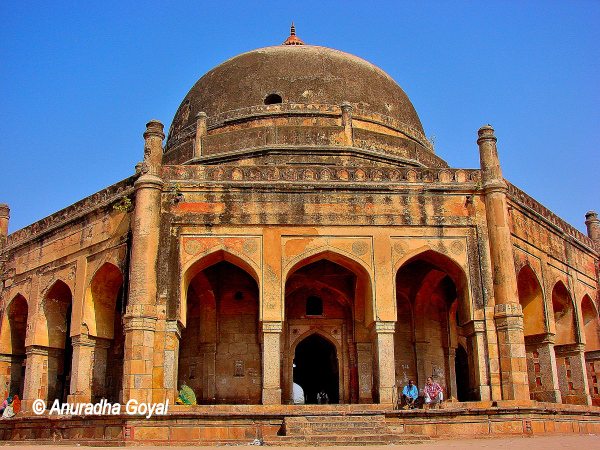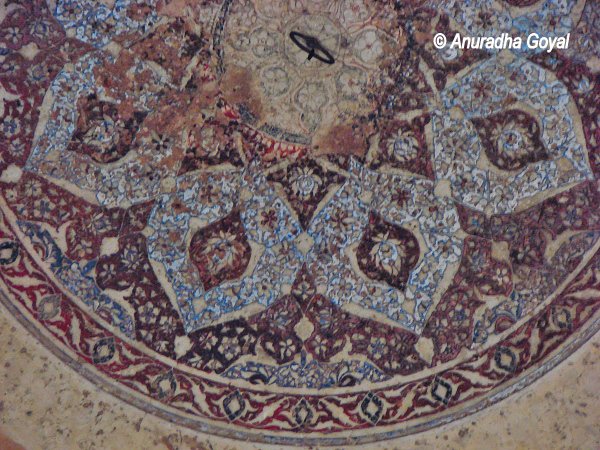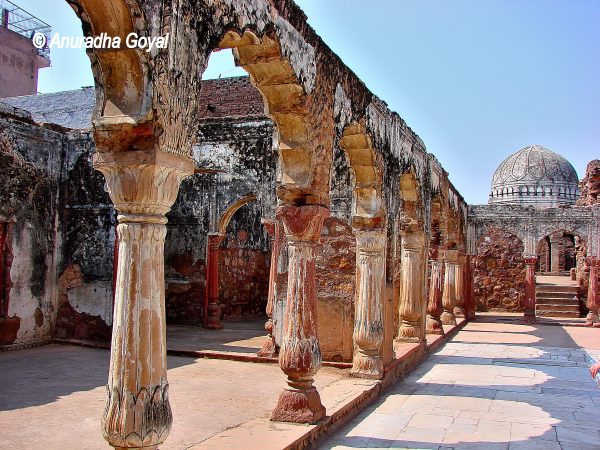Mehrauli being the oldest inhabited area in Delhi carries imprints of various eras in its small area. From the times of Tomars to the current day, there are ruins and remains that tell you the tales of their respective eras. When you walk across the lanes and bylanes of North Mehrauli it is like a small gathering of various eras. Where each era is sitting back and listening to the stories of others.

The older ones saying I have seen it all. And the younger ones wondered what was it like in the olden days.

North Mehrauli – Ruins & Remains
As you go ahead from Yogmaya temple towards the Mehrauli bus stand, bang opposite the bus stand you would see an imposing symmetrical building, with Indo-Islamic architecture staring at you. This is Adham Khan’s tomb. An ASI board that itself needs protection tells you that it is a protected monument. But never tells you anything more about the monument. It does not even tell you the name of the monument.
Adham Khan Tomb, North Mehrauli
Anyway, take a flight up the stairs and you would reach a wide platform on top of which this stands an astonishingly symmetrical octagonal structure. No wonder this is also known as Bhool Bhulaiya. You could be lost in this labyrinth-like structure. There are 8 double doors in this tomb. And the alternate doors have lotus and Islamic verses engraved on them.
All eight sides open into a verandah with 3 doorways each. There are Kumbhas on the entrance pillars. There are stairs to go up on the first floor. But all the ways are locked. So you can not go up and get a top-down view of the tomb. The huge dome adorns this structure and this may be one of the biggest domes, at least it seems so to the naked eye.
Painting on the Dome
On the top end of the ceiling of the dome has a circular painting in blue and red, which is not visible to the eye. But you can zoom in on your camera and see it. It is difficult to make out if the whole dome was painted once or if only this small circular part was. There are recessed arches and a corridor going around. The whole structure stands on a huge platform. There seem to be watchtower-like structures on the outer walls, which could have belonged to Lal Kot or maybe to the tomb.
I wish there was someone to explain this. Octagonal structure is not common in Mughal architecture. One of the theories states that Octagonal structures were built for traitors. And since Adham Khan was a traitor he got this octagonal tomb. Can someone tell me the reason or logic behind this?
Qutub Minar
You get a nice view of the Qutub Minar from North Mehrauli. Almost as if the mighty Minar is coming out of the earth like a plant. From another angle when you see the current day market through the various doorways. You see your eyes looking at the present through the past. Today this so-called protected monument is in bad shape with no maintenance. The walls are defaced, and there is filth all around. The platform and the monument are used by children as well as adults as a play area.

History
Adham Khan was Akbar’s foster brother. He was buried here along with his mother Mahamanga. This tomb was built by Akbar. The tomb stands on the walls of Lal Kot the 8th-century fort built by Tomar Kings. Surprisingly the grave is a very small structure inside this huge hall. But probably that is because it is a restored grave. In the early 19th century, this structure was used by the British as residential quarters, like a police station, and as a post office.
And as a rest house and was later restored by Lord Curzon. The myth is that Rani Roopmati whose lover Baaz Bahadur was killed by Adham Khan cursed him that no woman would visit his tomb. Well, I did visit it and did see a few more women at the tomb. There are not many people visiting the tomb, as it is not a part of popular itineraries.
War Memorial, Mehrauli

As you come back on the road, you would see another yellow-colored dome staring at you. And the boards all around it will tell you that it is a primary health center for the area. And the queues of patients will confirm that. On the wall is a memorial stone telling you that 1262 men from the Jails of Mehrauli and Badarpur went to the First World War and 92 lost their lives. Now, this building is intriguing because of the hybrid structure it has. It must have been a small dome from Mughal or earlier era.
Maybe a tomb but a verandah has potentially been erected by the British. You also see an old rubble wall, but with no clue which era it belongs to.
Gandhak Ki Baoli in North Mehrauli

Come out and walk across the road and take the first left lane. A few meters down you would see Gandhak ki Baoli. A five-story step well that was built by Iltutmish for the Sufi Saint whose dargah is next door. One of the sweepers there told us that the water from this Baoli used to smell of Gandhak (Sulphur), hence it is called Gandhak ki Baoli. He said that it had water till about 10 years back.
But now the water level of the area has gone down so much that there is hardly any water in this Baoli. He also told that the water was used only for bathing. And not drinking the water could cure all kinds of skin diseases. It is a smaller Baoli compared to the Rajon ki Baoli in Mehrauli Archaeological Park and is far less adorned.
There are steps on only one side and a pavilion-like structure on the top story of the opposite side. The other two sides are more or less only walls. Some literature says that the pavilion is a diving station and people probably used it for diving. But in the given state it is difficult to visualize. Like most other monuments, Gandhak ki Baoli also demands cleaning and maintenance, besides the ubiquitous ASI board.

Dargah Sharif, North Mehrauli
From here follow the signs to Dargah Sharif, which leads to the dargah of Hazrat Qutubuddin Bakhtiyar Kaki. It is the oldest dargah in Delhi. And probably the most revered one. It is a simple dargah compared to the Nizammudin. Like other landmarks of Mehrauli, there are add-ons from all generations that came to exist around this dargah. As you enter the Gali leading to the Dargah, you will start feeling the atmosphere in the air. There would be devotional Qawwalis playing in the background.
The series of small shops would try to sell you the things that are traditionally offered at the dargah. The most enchanting of them are the baskets full of flowers mostly dark pink roses.
A market in the lane
The narrow lane is adorned with chaddars of all colors with devotional images. And I assume inscriptions from the Quran are on them. There are Itr or perfume bottles. There are rosaries of all kinds including the made-in-China ones. And of course, the cassettes and CDs of the devotional songs and Qawwalis for you to buy. Then there are other items that you can buy as gifts like wooden curios that you find just about anywhere in India, books, and stands to keep the books. Some of the shopkeepers are busy spotting potential customers in the busy crowd.
While others are busy arranging flowers in the trays and baskets. Just sit back for some time and see the devotion with which people take these items from the shops and carry it to the dargah on their heads.

Stone on which Hazrat Nizamuddin used to stand

As one enters the Dargah, on the left side of the wall there is a huge stone embedded. People offer flowers on this stone and stop by to silently say a prayer. And then touch their forehead as if accepting a blessing. This is the stone on which it is said that Hazrat Nizammudin used to stand and pray to Baba Kaki. It is said that he used to come every day to visit this dargah and why not.
He is the disciple and successor of Baba Kaki and he carried forward the order of Chishtis in Delhi. As you move ahead you see a bright red gate with a marble strip carrying some inscriptions and small green minarets. This is definitely something that has been added later on by some king or nobleman.
And the latest addition seems to be the tube light hanging right on top of this gate. Enter through this gate you reach a courtyard with few graves in it. A curio shop and a team of Qawwali singers who sing only if there are listeners around and not just the God. There is a huge green sealed pot like a box where you can put your donations. Then there is another gateway, a simpler one this time in green and white that leads to the corridor leading to the dargah.
Unfortunately, women are not allowed beyond this Corridor. They have to look at the dargah from a distance and through a thick marble screen, from where even the camera lens can not pierce.
Marble Screen
I could have only a partial view of the dargah from this screen as there were people inside who came in the way even where the screen allowed. I could see a large tomb, golden pillars, and loads of green chaddars on top that is surrounded by closed eyes and raised hands praying to the saint. Unlike Nizamuddin Dargah, this one is open on all four sides and is not enclosed. Outside the screen, in the long corridor, you can see women with their heads touching the screen.
Some of them cry as if sharing their story with Baba, some cry for the pain in their lives, and some for the sheer affection of the Baba Kaki.
I think I was too busy resisting the screen and thinking how would be a place that has never been touched by any woman for more than 800 years, so could not really feel anything.
Baba Kaki Dargah in North Mehrauli

This dargah has existed for 800 years and in its complex are scattered numerous graves. Graves of devotees who wanted to be closer to their master’s afterlife. Baba Kaki was responsible for bringing this order of Chishti to Delhi from Ajmer. Which he did as per the desire of his master Moinuddin Chisti. This order is known for keeping away from the rulers and governments. And only focusing on divine pursuits.
The myth is that till Baba Kaki’s dargah is in Delhi, Delhi will survive come what may. And come to think of it, it has thrived despite all the turbulence that it had to go through. Today this shrine is one of the focal points of the celebrated Phool Waalon Ki Sair festival along with the Yogmaya temple, which is celebrated every year to date.
Zafar Mahal in North Mehrauli

Adjacent to the dargah is the Zafar Mahal built by Akbar II and enhanced by Bahadur Shah II. This is probably the youngest palace in the city. Less than 200 years old but in the worst state of existence which is attributed to its poor quality of construction. This may be the beginning of a bad construction quality era in Delhi. The huge triple-story gate of this palace is also called the Hathi Gate and is adorned with intriguing and broad Chajjas.
After you enter through the gate you would see perfect ruins, roofs falling apart, walls crumbling down, artwork peeping in from the debris. I could not make out anything about the architecture of this palace.
Mehrauli Ruins
There are domes standing out here and there. At times it seems that it might have been built by the rubble around it, but then you never know it might be the rubble from its own walls.
Moti Masjid
On the wall adjoining the dargah is Moti Masjid, a masjid in white marble. Partially restored and an imitation of the mosque of the same name in Red Fort. It is not really any exceptional masjid except for the shining white color. This is where Bahadur Shah Zafar wanted to be buried. And there is an empty grave still waiting for him there. There are members of his family who are buried here right next to Baba Kaki. You can go up and down the palace. But at your own risk as half the things are falling apart. The only thing that remains intact is the imposing gate it has.
From the top, you can get a top-down view of Mehrauli, which is an extremely crowded area. But if it was not so, then in those days it might have been a scenic view. And the queens and ladies from the Harem might have enjoyed their lives from these parapets. You can also see that the palace would have extended into large areas parts of which have now been encroached. There are houses built with walls of the palace.

Living Spaces
Outside all the monuments you would find groups of men playing cards. Using the alleys in these places as their meeting and playing areas along with all the neighborhood kids who would use these places to play hide and seek and other games. Now, this does take away the ambiance of the place. But at the same time, it keeps these places alive. You can feel life here because of the living people using these spaces. Otherwise, they would only be the resting places for those who may have lived and died multiple times over by now.
North Mehrauli is a must-do walk for all Delhi lovers and those who love exploring Delhi. Somehow most of the things on this walk are not on the popular itineraries of Delhi.
Recommend you to read the following travel blog on Places to Visit in Delhi.
Tughlaq Forts of Delhi – Tughlaqabad Fort & Adilabad Fort
Walk through the North Ridge of Delhi
Jain Temples of Mehrauli














wwwwwwwaaaaaaaaalllllaaaaaaaaaaaa maam ji.kya baat hai.so minute details.chaa gayi aap to.waiting fr MORE.thnx a lot
Hi ,Read after a long gap,before reading this, Mehrauli was just an address to me.Shruti
Its quite hard for me to relate spaces other than the usual tourist traps in the city. Being from Bangalore, I always though as Delhi of just chandni chowk, red fort, qutub minar etc.
You’ve brought out the charms of the city very well and next time I’m in Delhi, hope to use your posts on Delhi as a guide ! />Yogesh
बहुत बढ़िया जी । एक नया स्थान मिल गया ज़फर महल। बाकी जिन जगहों का जिक्र आपने किया वो देखी हैं लेकिन ज़फर महल नहीं देखा अभी तक। ये ज़फर महल ही है ? या ज़हाज़ महल ? और एक बात – आपने गंधक की बावली कब देखी ? क्योंकि मैं पिछले साल गया था तब इसमें गन्दगी भरी पड़ी थी और आपकी पिक्चर एकदम साफ़ और सुन्दर बावली दिखा रही है !!
Yogi – This is an old post, I would have seen Gandhak ki Baoli in 2010 or so.